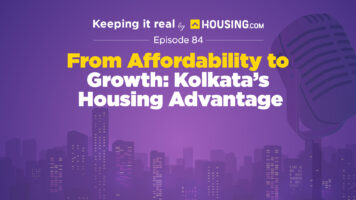As cities grow and climate concerns rise, one term keeps popping up: green buildings. But what exactly makes a building green? Is it just about slapping on solar panels, or is there more to it? And in a country like India, where affordability often trumps efficiency, is the green building movement realistic or overhyped? In this article, we delve deeper into the concept of green buildings and try to understand their credibility in an increasingly eco-conscious world.
See also: Green is the new gold: Why sustainable housing will drive India’s next property boom?
What is a green building?
A green building is one that is designed and built to reduce its environmental footprint, both during construction and throughout its use. Unlike traditional buildings that often rely on heavy resource consumption, green buildings aim for energy efficiency, water conservation, and sustainable material use, all while ensuring comfort and health for occupants. In practice, this might translate to increasing resource efficiency by harnessing natural resources. Solar panels, high-efficiency insulation, greywater recycling, and low-emission materials that together cut waste and pollution are some of its USPs.
Green buildings: Key features
So what exactly makes a building “green?” Here are some of the characteristics of green buildings:
Energy efficiency
Using natural light, installing LED fixtures, advanced insulation, and renewable sources like solar panels help reduce power consumption significantly. A passive design and efficient HVAC and lighting systems can slash electricity consumption by 30 – 50%.
Water management
Alongside power, efficient use of water is also a hallmark of green buildings. Rainwater harvesting, greywater recycling, and low-flow plumbing systems are often part of the design, providing long-term ecological benefits.
Sustainable materials
Construction materials are chosen for low environmental impact. Eco-friendly materials like fly-ash bricks, bamboo, recycled steel, and low-VOC paints are prioritised over conventional options.
Waste reduction
From construction waste segregation to on-site composting, green buildings aim to minimise landfill contributions. Even after the completion of the construction process, low waste generation remains a priority for green buildings.
Indoor environmental quality
Directing focus towards environmentally sustainable constructions automatically promotes occupant well-being. Better ventilation, daylight access, and non-toxic finishes make green buildings healthier to live and work in.
Smart design
Efficient floor plans, orientation for maximum sunlight, and shaded windows help reduce energy needs without extra tech.
Green building certifications in India
India is steadily positioning itself as a global leader in sustainable construction, and green building certifications are playing a big role in that transformation. Currently, the three most widely recognised green building rating systems in India are IGBC, GRIHA, and LEED India.
IGBC
The Indian Green Building Council (IGBC), a part of the Confederation of Indian Industry, has seen rapid adoption across sectors. As of 2024, over 15,800 projects have registered under IGBC certification, covering a built-up area of more than 13.5 billion sq ft. These include commercial complexes, IT parks, housing societies, hospitals, and more.
GRIHA
GRIHA (Green Rating for Integrated Habitat Assessment) is developed by TERI and backed by the Ministry of New and Renewable Energy. It is considered India’s national green building rating system, especially relevant for public projects. So far, more than 3,800 projects have been registered under GRIHA, accounting for an estimated 86 million sq m of built area.
LEED
LEED India, administered by the US Green Building Council through GBCI, brings an international framework to Indian projects. It has found favour particularly among corporates and commercial developers. In 2024 alone, over 370 projects were LEED-certified in India, covering close to 8.5 million sq m of area.
Green buildings of India: Interesting facts
- Hyderabad’s CII-Sohrabji Godrej Green Business Centre holds the distinction of being India’s first LEED Platinum-certified building. Designed as a demonstration hub for green practices, it laid the foundation for the green building movement in the early 2000s and continues to serve as a learning centre for sustainable development.
- Pune’s Suzlon One Earth campus is another iconic example. What sets it apart is that it operates entirely on on-site renewable energy, combining solar panels and wind turbines. The campus is certified both under LEED Platinum and GRIHA 5-star ratings, demonstrating that industrial-scale sustainability is achievable with smart design.
- Infosys’s Pocharam campus near Hyderabad is one of the country’s most energy-efficient IT office parks. With its emphasis on natural ventilation, daylight access, and high-performance systems, the campus has reportedly cut energy consumption by nearly half compared to standard office buildings.
- The ITC Green Centre in Gurgaon has long been a benchmark in commercial green design. Among the earliest large-scale LEED Platinum-rated buildings in the country, it integrates sustainable materials, efficient cooling systems, and zero-discharge water treatment — setting the standard for eco-friendly office infrastructure.
- In Jaipur, Hero MotoCorp’s Centre of Innovation and Technology (CIT) is a green industrial facility that brings together solar power generation, rainwater harvesting, and responsible material use. It holds top certifications from both IGBC and LEED, showing how sustainability can power innovation.
- Infinity Benchmark, a commercial high-rise in Kolkata, stands out for being among the first IGBC Platinum-rated buildings in Eastern India. Its early adoption of green features like daylight optimisation and energy monitoring reflects a growing shift in regional real estate practices.
- Mumbai’s Godrej Plant 13 Annexe, a manufacturing building, was a trailblazer as the first industrial facility in India to be awarded LEED Platinum status. It proved that sustainability isn’t limited to homes and offices — even factories can meet high environmental standards with the right approach.
- On the residential front, Tata Housing’s Shubh Griha in Boisar, near Mumbai, has shown that affordability and sustainability can go hand in hand. This low-cost housing project earned a GRIHA rating, making it one of the few affordable developments in the country to be officially recognised for its green credentials.
Advantages of green buildings
Wondering whether green buildings are worth the investment? Well, here is a list of the benefits they have to offer:
Significant energy savings
These buildings are carefully designed to optimise natural light, reduce dependence on artificial cooling, and integrate energy-efficient systems. Especially in a hot and humid climate zone like India’s, features like proper orientation, double-glazed windows, solar reflective roofs, and rooftop solar panels make a substantial difference. Green buildings can consume 30 to 50 percent less electricity than conventional ones, translating into significantly lower electricity bills over time. This is particularly valuable in Indian metros where energy costs continue to rise.
Water conservation
With many Indian cities facing acute water shortages, features like rainwater harvesting systems, low-flow plumbing fixtures, and greywater recycling are not just nice-to-have, but highly essential. These measures help reduce dependency on municipal water supply and underground water reserves. Over time, they lead to consistent water bill savings and offer greater resilience during water crises, which are increasingly common in urban areas like Bengaluru, Chennai, and Jaipur.
Healthier indoor environment
By prioritising natural light, enhanced ventilation, and non-toxic building materials, these spaces promote better indoor air quality and a more comfortable living or working experience. In India’s congested cities, where pollution often seeps indoors, this becomes even more important. Health benefits include reduced respiratory issues, better mental well-being, and improved sleep quality. Therefore, green homes and offices are not just environmentally responsible, but also healthier to live and work in.
Higher market and rental value
In India’s increasingly conscious property market, green-certified buildings are becoming a premium offering. Properties with certifications from IGBC, GRIHA, or LEED tend to attract more attention from buyers and renters alike. They are seen as smarter investments due to their lower operating costs, long-term durability, and alignment with future regulatory norms. This has led to higher resale values and quicker occupancy rates, especially in urban areas where sustainability is becoming a key factor in purchasing decisions.
Durability and lower maintenance
Green buildings generally use high-quality, sustainable materials that are more durable and longer-lasting than standard options. These include recycled steel, engineered wood, fly-ash bricks, and weather-resistant paints. Efficient mechanical systems such as HVAC and lighting are designed for low maintenance and optimal performance. As a result, green buildings tend to require fewer repairs and replacements over time. For homeowners, this means reduced operational hassles and lower annual maintenance expenses: a major plus for long-term ownership.
Reduced environmental footprint
By consuming fewer natural resources and producing less waste and pollution, they play a crucial role in combating climate change. Features like green roofs, energy metering, and construction waste management reduce the building’s overall carbon footprint. With rapidly expanding urban areas and environmental degradation being an urgent concern, adopting green building practices is not only smart but rather a necessity.
Where do green buildings fall short?
Green buildings have a set of drawbacks that might hinder people from choosing them. Here are some of the downsides we need to consider:
Higher initial investment
Incorporating sustainable materials, advanced systems, and energy modelling significantly adds to the construction budget. In India, this increase is usually between 2 to 10 percent depending on the scale and complexity of the project. For affordable housing or budget-conscious buyers, this added cost can be a barrier, even though the long-term savings on electricity and water typically offset the initial investment within a few years.
Need for skilled professionals
Architects, engineers, and contractors must be familiar with green technologies and sustainability standards to efficiently design a green building. In many Tier II and Tier III areas, there is still a shortage of such expertise. Without the right team, the execution of green features may be subpar, reducing the building’s performance and cost-efficiency.
Material availability and local adaptation
While sustainable materials are increasingly available in India, they are not uniformly accessible or affordable across regions. In smaller towns, options like certified wood, recycled aggregates, or low-VOC paints may be difficult to source. Additionally, certain green design features may not be effective in every climate. Tailoring green strategies to local climate and geography requires additional planning and expertise, which is not always feasible for every project.
Complex planning and regulatory delays
Building a green structure often involves more rigorous planning, documentation, and approval processes. Developers need to comply with green building codes like ECBC, coordinate with certification bodies, and sometimes wait longer for municipal clearances. These added layers of compliance can cause project delays, especially in jurisdictions where green construction is still relatively new. For time-sensitive or budget-constrained projects, these hurdles can be discouraging unless the local administration is proactive in supporting green development.
Limited reach in affordable housing
Despite strong momentum in premium and commercial real estate segments, green building practices are yet to become mainstream in India’s affordable housing sector. The primary reason is cost sensitivity, since low-income buyers are focused on immediate affordability, not long-term savings. Additionally, smaller developers often lack awareness or incentive to pursue green certification.
Are green buildings worth the hype?
Well, the concise answer to this pertinent question is: Yes, but with caveats.
India is among the top five countries in terms of green building footprint. Organizations like IGBC (Indian Green Building Council) and GRIHA are pushing the agenda with rating systems that cover energy use, water efficiency, and indoor air quality. The Energy Conservation Building Code (ECBC), rolled out by the Bureau of Energy Efficiency, mandates minimum energy performance standards for large buildings. Even the government is on board, offering incentives like:
- Reduced property tax
- Faster approvals
- Lower stamp duties for certified green homes
From Infosys campuses to affordable housing in Nagpur, real examples are proving that green buildings are not just “feel-good” ideas, but also cost-effective and future-ready.
That said, the reach is still limited mostly to urban and premium segments. For widespread adoption, we need stronger policies, builder awareness, and financing options that make going green feasible for the average Indian homebuyer.
Housing.com POV
Green buildings are more than just a trend; they’re a necessity in a world battling climate change, water shortages, and rising energy costs. While the upfront investment may be higher, the long-term benefits, environmental, financial, and health-related, make a strong case in their favour. While there has been a tangible shift in preference towards green buildings in India, it is still in the evolutionary phase. If implemented at scale and with intent, green buildings could redefine how we live, build, and grow.
FAQs
Are green buildings expensive to construct?
Construction of green buildings can cost about 2 - 10% more initially, but this is quickly recovered through lower utility bills.
Can I retrofit my existing home to make it green?
Absolutely. Consider starting small with solar panels, LED lights, water-saving fixtures, or even better insulation to eventually achieve a big impact.
Do green buildings really save energy and water?
Studies show savings of 30 - 50% in energy and 20 - 30% in water use compared to conventional buildings.
Is solar power mandatory in green buildings?
While it is not mandatory, it is highly recommended. Many state-level building codes now encourage or require solar readiness.
Are there certifications for green buildings in India?
IGBC, GRIHA, and LEED India offer green ratings for both residential and commercial buildings.
Can small homes or apartments be green?
Definitely. Size doesn’t matter. what counts is efficient design and responsible material use.
Are there government incentives for green homes?
Various state and central schemes offer tax benefits, faster approvals, and discounts for green-certified properties.
| Got any questions or point of view on our article? We would love to hear from you. Write to our Editor-in-Chief Jhumur Ghosh at jhumur.ghosh1@housing.com |







